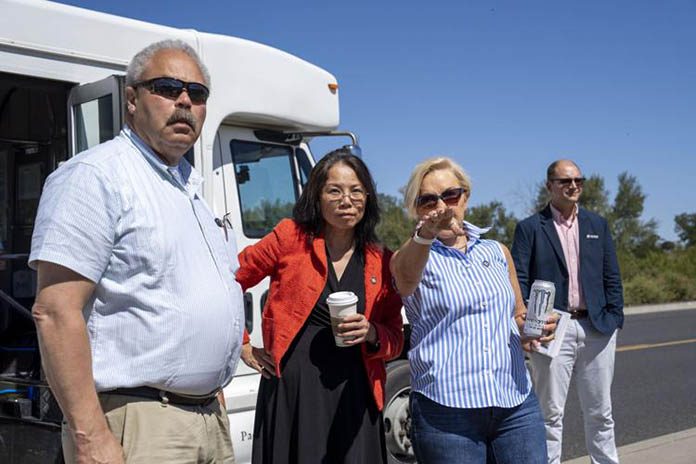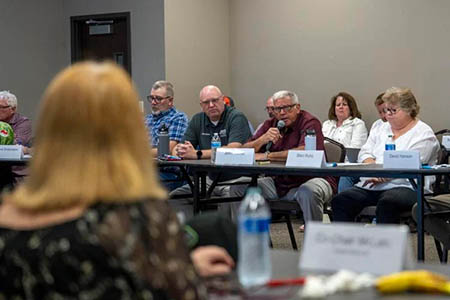
Local leaders from across Eastern Oregon offered thoughts and opinions on transportation, and its coming funding gap, to state legislators during a recent in-person meeting at the Eastern Oregon Trade and Event Center in Hermiston.
During a day-long meeting Thursday, Aug. 29, of the Joint Committee on Transportation, senators and representatives toured Umatilla County roads and met with officials from Wallowa, Umatilla and Morrow counties and cities before hearing from members of the public.
The meeting was the eighth of 12 in a series of transportation tours around the state during which the legislators are learning about challenges within the statewide transportation system as well as hearing ideas for possible solutions because funding for it will soon be at risk. The seventh stop, in Ontario, included a focus on passenger rail development, according to a press release, while the Hermiston stop centered around agricultural impact and emergency response.
The purpose of the meetings is to inform legislators as they “develop a plan in the 2025 session to maintain critical infrastructure, complete work on major projects, and guarantee the safety and diversity” of the state’s transportation systems, according to the press release.
“Our problem with our funding source is our funding source has leveled out and is starting to decline,” said Lee Beyer, Oregon Transportation Commission vice chair, “while the cost of the materials and contracts to work the system is going up.”
For communities across Eastern Oregon, ensuring funding for road operations and maintenance going forward is a top priority. Umatilla County Commissioner Dan Dorran said during the bus tour that the county doesn’t generally use its funding from the state’s gas tax to pay for capital improvements but for maintaining the roads and bridges that already exist.
“All transportation needs are local,” he said in an interview after the meeting. “Funding is statewide, but the needs are local, so just having this legislative body and the (Oregon Transportation Commission) folks here to see what is local to us makes all the difference in the world.”
Emergency impacts
On the tour, legislators learned about the 2020 Umatilla River flood’s impact on a bridge in Echo and how the shape of the river has since changed. The bridge is driveable, but there’s not enough funding to fortify the roads on either side of the bridge, offering an example of how natural disasters impact transportation.
Rep. Thuy Tran, D-Portland, is chair of the Committee on Emergency Management, General Government, and Veterans for the state. She said she was focused on what happens to the roads during disasters and how funding can help strengthen infrastructure so it’s still there even during emergencies.
“Eastern Oregon, it’s very spread out, lots of land to cover, and the folks out here have to maneuver that,” she said. “I was very surprised to see how much commerce is passing through Eastern Oregon, getting our products finished and raw to the market. And so, maintaining transportation, especially in an emergency, is so vital for the economy of Eastern Oregon, but also for our state.”
Other highlights of the tour showed the impact of freight and truck movement on local roads because of agriculture and the state of Interstate 84 going to Hermiston, which is 56 years old.
Dani Schulte, transportation planner for the Confederated Tribes of the Umatilla Indian Reservation, told legislators about the bus routes the tribes’ Kayak Public Transit traverse across several rural counties. Throughout the day, she emphasized the importance of access to public transit for those without cars as well as safety for the most vulnerable road users — walkers and bicyclists.
Open to ideas
After the tour came a roundtable session between the legislators and local leaders from organizations, agencies, counties and cities across the region. Hermiston Mayor Dave Drotzmann and Pendleton Mayor John Turner showed up, as did county commissioners from Morrow, Umatilla and Wallowa counties. City council members from Echo attended alongside emergency responders from Umatilla County Fire District No. 1.

Many people mentioned their main concern for the future of the region’s transportation was maintaining the funding levels and breakdown from the state’s gas tax, of which 50% goes to the state, 30% to the counties and 20% to the cities. They said they want a solution and a funding source that’s equitable across the state.
By the end of the roundtable, the local leaders said there wasn’t a solution — such as a road user fee or a gas and electric recharge tax — that was firmly off the table for them until more analysis is completed and they have a better understanding of the impacts of various approaches.
Jeff Baker, a member of the Oregon Transportation Commission, said the major themes he heard during the roundtable were about safety, market access for agriculture, consistency and sustainability with funding and meeting the needs of all people, both across the state and across socioeconomic classes.
“And then I heard that weather is a way of life in Eastern Oregon, it’s not an event,” he said. “We need to be reminded of that.”
For Sen. Lynn Findley, R-Vale, one of the major takeaways was that a one size fits all solution is not, in fact, equitable for many of the people living in Eastern Oregon, especially if that solution is a blanket road user fee.
“What I heard between the lines, you can’t penalize someone for living in rural Oregon,” said Findley, a member of the joint committee. “The people in rural Oregon have just as much right to a good road as the people in Western Oregon.”









